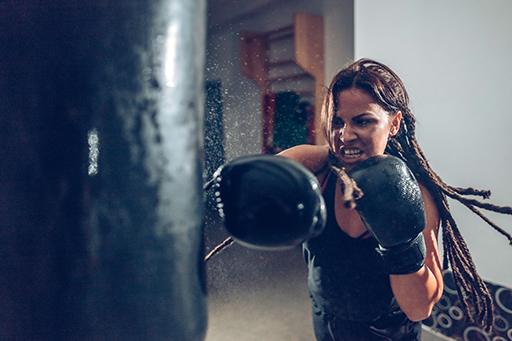4 How can personality increase the risk of injury?
Most research exploring the effect of psychological factors on injury risk has examined the relationship between stress and injury. However, much research has also been undertaken examining the link between personality and injury.
As you saw in Section 2, personality is also a component of the Stress and Injury model (Figure 2) where it is suggested that personality factors (e.g. competitive trait anxiety) can be a moderator of the stress response, influencing for example how likely someone is to perceive (cognitively appraise) a situation as stressful. These personality characteristics can be split into:
- positive personality traits – traits that allow the individual to perceive a situation as challenging rather than threatening, thus resulting in a lower stress response and lower risk of injury, and
- negative personality traits – traits that lead an individual to perceive a situation as threatening, thus resulting in a higher stress response and higher risk of injury (Appaneal and Habif, 2013).
A wide range of personality characteristics have been investigated as being linked to sport injury risk. In their review of forty-five research studies, Appaneal and Habif (2013) identified more than twenty personality characteristics but suggest that three have received the most attention – anxiety, locus of control and mental/emotional states. You will explore these in the next activity.
Activity 3 Personality characteristics and sport injury
Read the extract from Appaneal and Habif (2013) below which explores the three personality characteristics that have received the most research attention, and then answer the questions that follow.
Psychological antecedents to sport injury (Appaneal and Habif 2013)
- What is competitive trait anxiety and how does it link to sport injury? Why do you think this might be?
- What is ‘locus of control’ and how strong is its relationship with sport injury?
- What is the relationship between mood and injury risk?
Discussion
- Competitive trait anxiety is where an individual has a tendency to perceive competitive situations (e.g. sport competition) as threatening and respond with stress and anxiety. Unsurprisingly, the research suggests that those with higher levels are at greater risk of injury, but why is that the case? If you are anxious about competition you are likely to have a stronger stress response and increase your risk of injury. Additionally, as outlined in the extract, factors such as poor sleep and nutrition as a result of anxiety may inhibit sport performance and lead to an injury.
- ‘Locus of control’ is the individual’s perception of who or what is responsible for what happens to them (internal or external factors). It is hypothesised that those with a higher internal locus of control (i.e. someone who believes that they, rather than external forces, are responsible for outcomes they experience) were more likely to suffer an injury. However, the evidence for this is limited with only two out of the nine studies Appaneal and Habif (2013) reviewed supporting this.
- People who exhibit negative mood states such as anger appear more likely to develop a sport injury. Perhaps being angry leads to changes in behaviour (e.g. going in for hard tackles) that increase the risk of injury.

